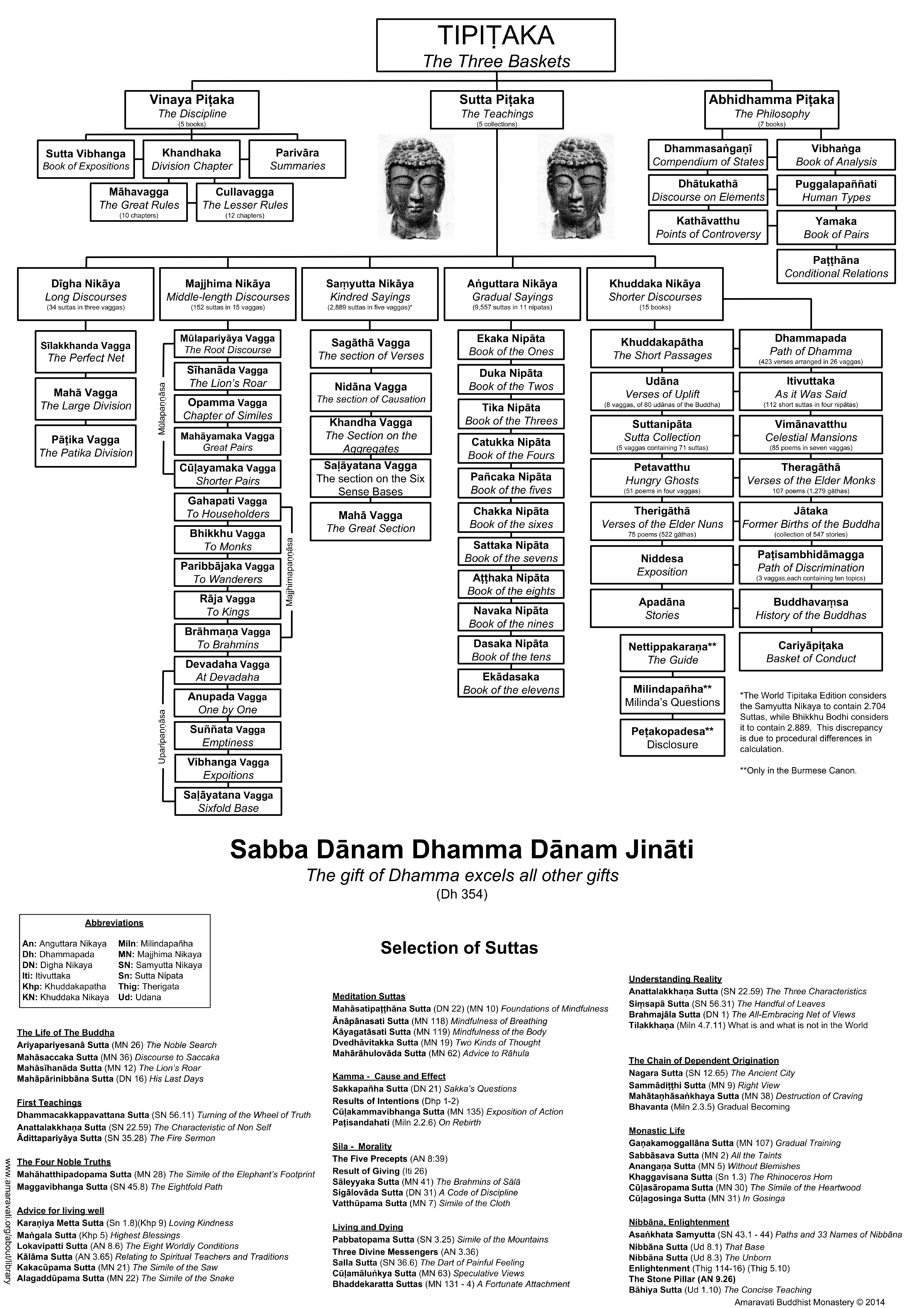Recommendation for Suttas
score:3
Well DN and Mn are long copies of suttas from AN and SN. The problem with AN and SN is their size.
Since people today say that the suttanipata [=Snp] chapter 4 and 5 are the oldest texts, and that They are read in a few hours tops, you can start here:
http://ftp.budaedu.org/ebooks/pdf/EN391.pdf
https://www.accesstoinsight.org/tipitaka/kn/snp/index.html
So the order would be about starting with short texts and collections, then the big collections, then go back to DN for a summary: sutta nipata chapter 4, 5, then 1, 2, 3, then MN, people like the dhammapada too so why not, Then SN and AN in no order, Then DN, then all the little added stuff in KN. Of course, there is the vinaya and the abidhamma too....
Here is a picture of all the catalog
The famous Bikkhu Sujato has written a few guides about all those Nikayas
A Reader’s Introduction to the Pali Nikāyas https://discourse.suttacentral.net/t/a-reader-s-introduction-to-the-pali-nikayas/11507
more guides here https://discourse.suttacentral.net/c/reading-guides
Instead of reading, There are also records of MN, AN, Snp, KN, SN, DN https://bodhimonastery.org/online-dharma-lectures
https://www.youtube.com/user/venbodhi/videos
http://www.suttavinaya.com/list-of-topics/
https://www.youtube.com/user/vbgnet98/videos
It will take a while to read or hear all that, especially if you do not spend the whole day doing that, so it is even better to begin with the short texts.
Upvote:0
IMHO, this is my recommendation:-
Start with Digha Nikaya. It is more suited for "beginners" because the Suttas take the trouble to explain the fundamentals and the little-but-later-on-important items.
In the Majjhima Nikaya, the reader is expected to already know many of the fundamentals and the Suttas start to get "terse".
And finally, the Samyutta Suttas, which is even terser.
Many people also took up Abbidhammas at some point, but personally, I found that many of the items described in there could only be properly understood by a Samatha meditation practitioner.
Upvote:0
The proper way to follow gradual instruction/progressive teaching (Ānupubbī-kathā) given by the Lord Buddha when it was necessary to first prepare the listener's mind before speaking to him on the advanced teaching of the Four Noble Truths.
- Generosity (dāna)
- morality (sīla)
- Heaven (sagga)
- Danger of sensual pleasure (kāmānaṃ ādīnava)
- Renunciation (nekkhamma)
- The Four Noble Truths (cattāri ariya-saccāni)
The last one is called Sāmukkamsika desanā which describes suffering, its cause, its ceasing, and the path.
The purpose of this gradual instruction is to ensure that the listener's mind was prepared, pliant, free from obstacles, elevated and lucid enough to understand the four noble truths.
~ Reference: Ānupubbī-kathā
Suttas about Generosity
- Siha Sutta: To General Siha (AN 5.34)
- Dana Sutta: Giving (AN 7.49)
- Sangaha Sutta: The Bonds of Fellowship (AN 4.32)
Suttas about Morality
Suttas about Heaven
Suttas about danger of sensual pleasure
Suttas about Renunciation
Suttas about the Four Noble Truths
Note: This is what I understood. I may be wrong but not Dhamma.
Upvote:0
In the Buddha's words by Bhikkhu Bodhi is great. He picks suttas from all the Nikayas so you don't have to. They are arranged by themes to aid dipping into.
More post
- 📝 Is there a connection between Guilt and Fear?
- 📝 What does Buddhadasa say about rebirth after the break-up of the body?
- 📝 Buddhism and Novelty of Persons
- 📝 Seventy Topics - 6*6 = 36 paramitas
- 📝 Leave pain while enjoying life?
- 📝 What are the traditional Buddhist arguments for rebirth?
- 📝 Please Recommend Pure Land / Other Power Buddhism Books
- 📝 Pāramitāyāna and Tantrayāna
- 📝 Is there a compassion only Buddhist path?
- 📝 How does one do an "eye opening" for a new statue?
- 📝 Any advice for beginners about Vipassana traditions?
- 📝 A Monk Reborn in a Lower Realm for Breaking a Leaf
- 📝 Anatta during meditation
- 📝 Details for Kasina Meditation
- 📝 practicing the brahma viharas in meditation
- 📝 Term for instructual terms
- 📝 Impermanence (Anicca) and Mindfulness in general
- 📝 What is the meaning of uppajjati versus upapajjati?
- 📝 Have Buddhas escaped samsara?
- 📝 Is the path considered or viewed as being selfish?
- 📝 Did the Buddha ever teach that we have a special responsibility to those we have injured?
- 📝 what those wrong views mean?
- 📝 How should one look at buddhist mythologies and cosmologies from a scientific perspective
- 📝 At what age does a person becomes capable to understand Buddhism?
- 📝 Is there a way to help us remember our previous life?
- 📝 Meditation on a concept
- 📝 What is the meaning behind the concept of "gods" in Buddhism?
- 📝 A Problem in Need of an Answer
- 📝 Enlightenment finding me
- 📝 What does love means?
Source: stackoverflow.com
Search Posts
Related post
- 📝 Recommendation for Suttas
- 📝 Recommendation - Book for beginner
- 📝 Which suttas in the Pali canon give instructions for how to cultivate equanimity?
- 📝 Basic abridged suttas in English and only English for chanting along with TTS
- 📝 Is Nirvana the goal for all Buddhist?
- 📝 Is a belief in rebirth a necessity for Buddhist practice?
- 📝 Chronological or other sequence for beginners
- 📝 Are actions in computer games bad for karma?
- 📝 Is Buddhism just Hinduism stripped for export?
- 📝 Isnt the desire for giving up the desires, a desire?
- 📝 Is zazen practised for its own sake, or as a means to end suffering? Experts seem to say different things
- 📝 Methods for reaching Jhana
- 📝 Does meditation increase productivity for software developers and related professions?
- 📝 A Good Career for a Buddhist?
- 📝 How can I remove my desire for a relationship/girlfriend?
- 📝 Can environmental degradation be used as a justification for the culling of an invasive alien species?
- 📝 Am I condemned for an extramarital affair?
- 📝 Did the Buddha speak Pali? Are the suttas his word verbatim?
- 📝 Buddhist (Theravada) cure for "Insecurity"?
- 📝 Learning materials for Dependent Origination (Paṭiccasamuppāda) in Theravada Buddhism
- 📝 In meditation, should one pursue tranquility first, prior to looking for insight?
- 📝 Details for Kasina Meditation
- 📝 What is the recommended time of day for meditation?
- 📝 What is the minimum amount of time needed for a productive meditation sit?
- 📝 How much is the minimal time for practicing Vipassana in daily life for achieving better mindfulness?
- 📝 What dietary practices are most helpful for reaching enlightenment?
- 📝 Who said 'if you are too busy meditate for two hours'?
- 📝 Why is contributing to the market demand for meat not wrong?
- 📝 Will working for a company that engages in animal experimentation to alleviate suffering of humans be wrong livelihood?
- 📝 What is the motivation for the list of 5 deadly sins?



